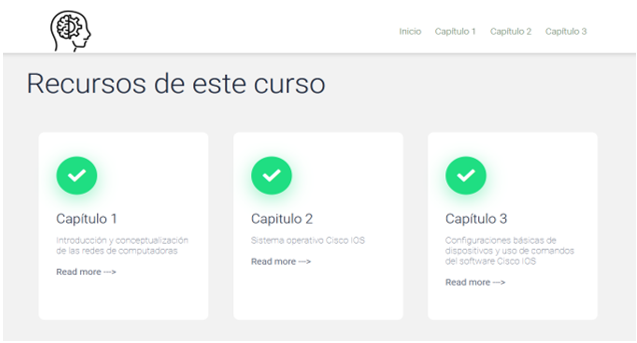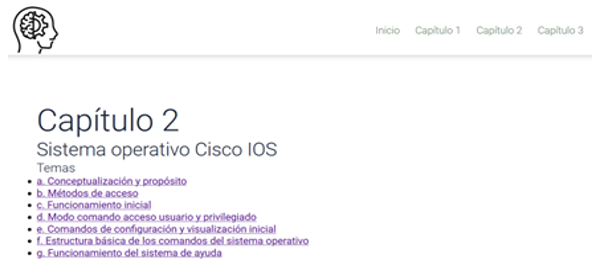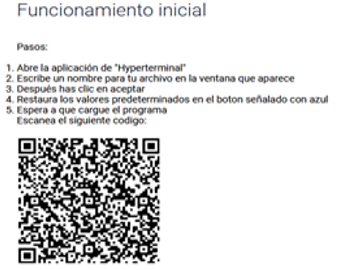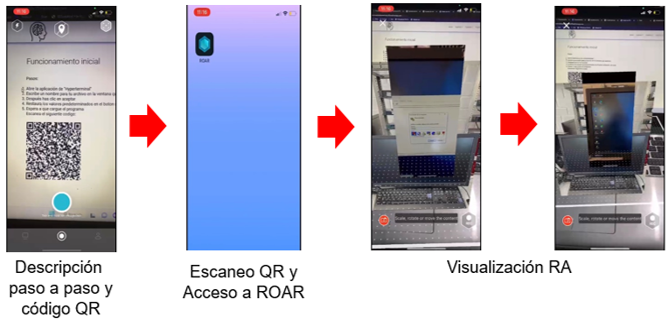doi: 10.56294/mw2024539
ORIGINAL
Implementation of Augmented Reality in the Teaching of Computer Networks
Implementación de Realidad Aumentada en la Enseñanza de Redes de Computadoras
María Guadalupe
González Novoa1 ![]() , Horacio Gómez Rodríguez2
, Horacio Gómez Rodríguez2 ![]() *,
Maricela Jiménez Rodríguez1
*,
Maricela Jiménez Rodríguez1 ![]() , Juan Carlos Estrada Gutiérrez1
, Juan Carlos Estrada Gutiérrez1 ![]() , Aidé Alejandra Flores Cervantes1
, Aidé Alejandra Flores Cervantes1
1Universidad de Guadalajara. Departamento de Ciencias Básicas. Guadalajara.
2Universidad de Guadalajara. Departamento de Ingenierías. Guadalajara.
Cite as: González Novoa MG, Gómez Rodríguez H, Rodríguez MJ, Estrada Gutiérrez JC, Flores Cervantes AA. Implementation of Augmented Reality in the Teaching of Computer Networks. Seminars in Medical Writing and Education. 2024; 3:539. https://doi.org/10.56294/mw2024539
Submitted: 12-12-2023 Revised: 18-05-2024 Accepted: 17-08-2024 Published: 18-08-2024
Editor: PhD.
Prof. Estela Morales Peralta ![]()
Corresponding Author: Horacio Gómez Rodríguez *
ABSTRACT
The advancement of digital tools has significantly transformed the daily lives of undergraduate students, especially in Computer Engineering, Informatics and Mechatronics. At the Centro Universitario de la Ciénega, located in Ocotlán, Jalisco, various technologies are used in computer networking courses, whose main objective is for students to develop interconnection, configuration, and communication skills between computers through switches and routers in a specialized laboratory. This communication exhibits the implementation of Augmented Reality as a teaching methodology, integrating guided activities through a website. The activities describe step by step the practical procedures, so that students can visualize the network devices “almost” in reality through interactive photographs taken with their smartphones or tablets, as if they were physically in the laboratory. Augmented Reality is implemented by combining digital information with real situations that appear in images. The website covers the topics of the subject, which are organized in chapters, which students can access through QR codes. Students scan the QR codes and can then launch the ROAR app, which adds an augmented reality experience to the content, thereby enriching their understanding and practical learning of computer networks.
Keywords: Augmented Reality; Computer Networks; Interactive Learning; Information Technologies.
RESUMEN
El avance de las herramientas digitales ha transformado significativamente la vida cotidiana de los estudiantes de pregrado, especialmente en Ingeniería en Computación, Informática y Mecatrónica. En el Centro Universitario de la Ciénega, ubicado en Ocotlán, Jalisco, diversas tecnologías son utilizadas en las asignaturas de redes de computadoras, cuyo objetivo principal es que los estudiantes desarrollen habilidades de interconexión, configuración y comunicación entre computadoras mediante switches y routers en un laboratorio especializado. Esta comunicación exhibe la implementación de la Realidad Aumentada como metodología de enseñanza, integrando actividades guiadas a través de un website. Las actividades describen paso a paso los procedimientos prácticos, de manera que los estudiantes puedan visualizar “casi” en la realidad los dispositivos de red a través de fotografías interactivas realizadas con sus smartphones o tabletas, como si estuvieran físicamente en el laboratorio. Se implementa la Realidad Aumentada combinando información digital con situaciones reales que aparecen en imágenes. El website abarca los temas de la materia, los cuales están organizados en capítulos, a los que los estudiantes pueden acceder mediante códigos QR. Los estudiantes escanean los códigos QR y pueden, a partir de ellos, empezar la aplicación ROAR, que añade la experiencia de la realidad aumentada al contenido, enriqueciendo así la comprensión y aprendizaje práctico de redes de computadoras.
Palabras clave: Realidad Aumentada; Redes de Computadoras; Aprendizaje Interactivo; Tecnologías de la Información.
INTRODUCTION
In the field of education, the pandemic situation has contributed to the use of digital platforms and, with this, to the modification of the teaching and learning process through the exploration of new technologies for accessing curricular content in a dynamic and accessible way.(1)
Information and Communication Technologies (ICT) have facilitated the approach to virtual teaching, although some subjects require practical activities with physical interaction with specialized equipment. The practical modality is fundamental in subjects such as Computer Networks (RC) and Network Administration (AR), which are part of the CCNA program of Netacad within the Computer Engineering at the University Center of La Ciénega. These subjects require specialized laboratories, although the shortage of equipment to which they are restricted can mean that not all students can access them. To address this limitation, we use simulators, emulators, and Augmented Reality (AR).(2)
AR combines digital and physical elements, facilitating the perception of augmented environments in areas such as electricity, magnetism,(3) visual innovation in the classroom,(4) electronic circuits, and telemedicine(5) among others. Its integration improves interactive learning through mobile devices or tablets, bridging the gap between face-to-face and virtual teaching.(6)
AR in education encourages curiosity and creativity in students, facilitating the understanding of content through experimentation.(7) In higher education, ICTs are fundamental for knowledge development.(8) As Camilloni points out: “without practice, there is no professional training”.(9)
Universities must guarantee training that integrates theory and practice, responding to social demands.(10) AR improves the quality of education by allowing the construction of virtual objects for didactic purposes, facilitating meaningful learning and innovation.(11) Its implementation favors knowledge retention and allows extrapolating content outside the classroom, fostering experimentation and interactive learning.(12)
AR offers individualized teaching-learning processes for students and can be implemented in various subjects to improve the understanding and transmission of knowledge interactively.(13) Its application in computer networks allows students to visualize configurations and procedures interactively, optimizing teaching and improving accessibility to educational content.(14)
METHOD
The methodology used for developing and implementing the software to integrate the practical activities guided step by step using AR was based on Extreme Programming (XP) by Kent Beck as a discipline for developing software. This paradigm frames the agile methodology, proposing simplicity and speed in creating high-quality systems adapted to changing needs, in addition to evolution, considering basic activities at each stage of planning, design, development, and testing.(15)
Planning and design
To carry out the planning and integration of AR technology in combination with authentic images and environments, the computer network laboratory in Cuciénega was available at the time of the theoretical and practical explanations by the teacher to capture real-life situations and visualize them on the camera with virtual information incorporating the expanded digital format; the images were associated with specific static images necessary to describe each activity step by step. This process took place multiple times, allowing the images to be captured in the classes given.
Likewise, the SW and RO network devices located in the specialized laboratory were used so that when aligning the markers in front of the camera, they were displayed with the associated 3D image. They could be visualized in one image when using more than one marker at a time.
Three components were considered for the implementation of AR
1. Real objects that function as a reference for the interpretation and creation of virtual objects.
2. Device with a camera to transmit the image of the real object.
3. Software to interpret the signal transmitted by the camera in real time and transmit the image combined with 3D projections.
Technical specifications and types of components
Real objects:
· Cisco Systems model 2911 router, allows the connection of communication devices and services, figure 1.
· Cisco Systems model 2960 switch, a device that allows connection and communication in a network, figure 2.
· 1 UTP category network cable (unshielded twisted pair cable) cross type, see figure 3.
· 1 UTP category network cable (unshielded twisted pair cable) straight type, see figure 3.
· 1 console cable.
· 1 desktop computer or laptop.
· Specialized computer network laboratory, figure 5.
· Internet connection.

Figure 1. Switch-router devices

Figure 2. Switch-UTP connectivity

Figure 3. UTP cables
Device with a camera to transmit the image of the real object
Smartphone with Android operating system and integrated camera.
Software to interpret the signal transmitted by the camera
ROAR software (Augmented Reality App Scanner, developed by ROAR IO Inc., free license, downloaded from the Play Store) installed on the Smartphone that allows you to scan the QR code to visualize the AR activities, see figure 4.
Source: ROAR images from https://napkforpc.com/es/apk/com.roar.scanner/
Figure 4. ROAR access and installation
To select the practical activities, the design was planned to be implemented using the client/server model, which consists of enabling a "service" for access to information, allowing multiple connections or requests sent by "clients" (students' smartphones/tablets) through the browser and internet connection to access the web server (which receives the requests from the client connections) which would contain the pages with the main topics of the (students' smartphones/tablets) through the browser and internet connection to access the web server (which receives requests from client connections) which would contain the pages with the main topics of the CR and AR subjects, figure 5.

Figure 5. Client/server model
Testing and development
For the presentation of the tests as part of the development to achieve AR implementation, three components were integrated for the creation of virtual objects:
· Real SW and RO devices.
· Implementation of the client/server model.
· Use of ROAR on smartphone/tablet.
Creation of virtual objects and real OW: interpretation and creation of the objects with screenshots of multiple photographs to add the markers verifying the description of each of the steps carried out in the practical activities, subsequently generating the QR codes for each topic.
Implementation of client/server model: free web hosting was used for the server, the pages were programmed using HTML (Hypertext Markup Language) and PHP (Hypertext Pre-Processor), and as a result the main page was developed to integrate the topics by chapters and linked to the practical activities (figure 6).

Figure 6. Access to web server
The tests carried out involved teachers and students using their smartphone or tablet to download and install the ROAR software to access the website or home page and select a topic by scanning the corresponding QR code to visualize the guided AR configuration procedure, figure 7.

Figure 7. AR access and visualization
RESULTS
The main web page (figure 8) contains a brief introduction that integrates three chapters with theoretical information in order to complement the practical activities visualized with AR (figure 9).

Figure 8. Main web page

Figure 9. Course chapters
.
The topics of each chapter can be selected and then directed to the website that corresponds to the topic (figure 10). For example, the guided steps of the theoretical-practical activity called Initial Operation, is located in Chapter 2, therefore, when selecting the topic, it is directed to the activity page and is presented as in figure 11 and contains a QR code (figure 11).

Figure 10. Website

Figure 11. Initial operation
The QR code is scanned with the smartphone/tablet and allows the ROAR application to be run to visualize the images. The corresponding guided activity can be seen with AR through the augmented images, figure 12.

Figure 12. AR visualization
The client/server model allows access and communication over multiple connections so students can enter the web page that integrates guided topics with a detailed description and the integration and visualization of augmented reality technology in each activity.
The website was implemented on a server that allows access to the topics, which are not illustrations or photos; they are images treated as superimposed marks captured by the camera that interacted with the teacher when carrying out the laboratory practices. The aim is to implement real but augmented technology and promote interaction with real-virtual objects with the explanations represented by the images. In this way, students can perceive an augmented experience of the virtual object available in each activity.
Augmented reality technology offers an attractive way to interact with and perceive the reality of things, allowing access to theoretical and practical activities with the idea of motivating and arousing interest in students, who can appreciate augmented reality as similar to 3D pleasantly and easily, interacting through their smartphone or tablet.
CONCLUSIONS
Augmented reality reinforces experimentation and practice, thus favoring the teaching and learning process, especially for visualizing practical activities in networks through step-by-step guided activities, especially when specialized devices or equipment are required to perceive the interaction of augmented reality as if the students were physically in face-to-face classes. However, classes and courses with augmented reality can be a form of virtual attendance with the possibility of connecting via mobile device/tablet for a better use of technological and educational resources.
This is a relevant aspect of the positive impact on student motivation and commitment, as it makes it possible to complement and reinforce the content of subjects based on the practical modality where their thematic content requires the use and physical interaction to carry out exercises necessary to promote autonomous learning, problem-solving, and the development of digital skills needed for professional training.
The implementation of AR in the educational field presents some challenges. It is important to train teachers to adapt it to the curriculum and implement it as an educational technology since it combines the real and virtual environment; it is a form of interaction with physical reality with visibility through a technological device directly or indirectly that can contribute as a teaching-learning methodology in the area of computer networks.
Based on AR, it is an innovative tool for teaching computer networks, incorporating information, combining theory and practice, and creating interactive spaces. Its use in higher education improves students' understanding of the subject content so that they can acquire their own learning through a motivating experience and flexible and dynamic learning.
Students require constant personalized feedback so that each can learn at their own pace. AR allows direct interaction with equipment or devices as if they were carrying out activities in the laboratory on repeated occasions, which can be considered to achieve meaningful learning or reaffirm acquired knowledge, as well as contribute to their self-learning.
Future work will continue to investigate its impact, conduct a study to show academic performance, and analyze the benefits of guided practical, experiential learning from the perspective of students using AR to assess meaningful learning and academic performance, and expand an effective methodology in training technology professionals.
BIBLIOGRAPHIC REFERENCES
1. Cabero-Almenara J, Vázquez-Cano E, Villota-Oyarvide WR, López-Meneses E. La innovación en el aula universitaria a través de la realidad aumentada: análisis desde la perspectiva del estudiantado español y latinoamericano. Rev Electron Educare. 2021;25(3):1-17.
2. Basogain X, Olabe M, Espinosa K, Rouèche C, Olabe JC. Realidad aumentada en la educación: una tecnología emergente. Escuela Superior de Ingeniería de Bilbao, EHU. 2007. Disponible en: http://bit.ly/2hpZokY
3. Martínez PU, Piccinelli G. Realidad aumentada y la innovación educativa para el estudio del electromagnetismo con ingenieros en computación. 5to Encuentro Universitario de Mejores Prácticas de Uso de TIC. 2019. Disponible en: https://educatic.unam.mx
4. Rupay-Palomino RR, Coral-Ygnacio M. Un software educativo utilizando el aprendizaje basado en problemas con realidad aumentada. Rev Iberoam Tecnol Educ. 2023;34:49-58. Disponible en: http://dx.doi.org/10.24215/18509959.34.e5
5. Cerezo Palma EL, Muñoz León DG. Aplicación de realidad aumentada en educación [Tesis]. Universidad de Guayaquil; 2023. Disponible en: http://repositorio.ug.edu.ec/handle/redug/67269
6. Yerbabuena Torres A. Realidad aumentada en el proceso de enseñanza-aprendizaje de biología en el bachillerato general unificado de la Unidad Educativa. 2023.
7. Vidal Ledo M, Lío Alonso B, Santiago Garrido A, Muñoz Hernández A, Morales Suárez I, Toledo Fernández A. Realidad aumentada. Educ Med Super. 2017;31(2). Disponible en: https://ems.sld.cu/index.php/ems/article/view/1161/515.
8. Heras Lara L, Villarreal Benítez JL. La realidad aumentada: una tecnología en espera de usuarios. Rev Digit Univ. 2004;5(7). Disponible en: http://www.revista.unam.mx/vol.8/num6/art48/int48.htm.
9. Castro S, Guzmán B, Casado D. Las TIC en los procesos de enseñanza y aprendizaje. Laurus. 2007;13(23):213-34. Disponible en: https://www.redalyc.org/articulo.oa?id=76102311.
10. Cruz Pérez MA, Pozo Vinueza MA, Andino Jaramillo AF, Arias Parra AD. Las Tecnologías de la Información y la Comunicación (TIC) como forma investigativa interdisciplinaria con un enfoque intercultural para el proceso de formación de los estudiantes. E-Ciencias Inf. 2018;9(1). Disponible en: https://doi.org/10.15517/eci.v1i1.33052.
11. Camilloni A. Seminario de teorías del aprendizaje. Instituto Académico Pedagógico de Ciencias Humanas. Universidad de Buenos Aires (UBA); 2018. Disponible en: https://www.unvm.edu.ar/noticias/humanas/destacan-la-importancia-de-la-relacion-entre-teoria-y-practica/.
12. González-Sanmamed M, Estévez I, Souto-Seijo A, Muñoz-Carril P. Digital learning ecologies and professional development of university professors. Comunicar. 2020;62:9-18. Disponible en: https://doi.org/10.3916/C62-2020-01.
13. Duniesky Dorta Pina, Barrientos Núñez I. La realidad aumentada como recurso didáctico en la enseñanza superior. Rev Cubana Cienc Inform. 2021;15(Esp):146-64. Disponible en: https://www.redalyc.org/journal/3783/378370462010/html/.
14. Cevallos Jurado JC, Del Valle Saltos DB. Realidad aumentada en el aprendizaje creativo en la asignatura de matemáticas [Tesis de licenciatura]. Universidad de Guayaquil; 2022.
15. Letelier P, Penadés MC. Métodologías ágiles para el desarrollo de software: eXtreme Programming (XP). Univ Politécnica Valencia. 2012;17.
FINANCING
No financing.
CONFLICT OF INTEREST
None.
AUTHORSHIP CONTRIBUTION
Conceptualization: María Guadalupe González Novoa, Horacio Gómez Rodríguez, Maricela Jiménez Rodríguez, Juan Carlos Estrada Gutiérrez, Aidé Alejandra Flores Cervantes.
Data curation: María Guadalupe González Novoa, Horacio Gómez Rodríguez.
Formal analysis: Maricela Jiménez Rodríguez, Juan Carlos Estrada Gutiérrez.
Research: Juan Carlos Estrada Gutiérrez, Aidé Alejandra Flores Cervantes.
Methodology: María Guadalupe González Novoa, Horacio Gómez Rodríguez.
Project management: María Guadalupe González Novoa.
Drafting - original draft: Aidé Alejandra Flores Cervantes.
Writing - proofreading and editing: María Guadalupe González Novoa, Horacio Gómez Rodríguez, Aidé Alejandra Flores Cervantes.
